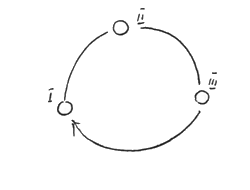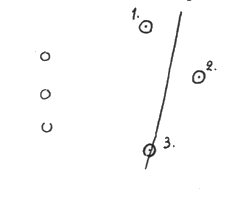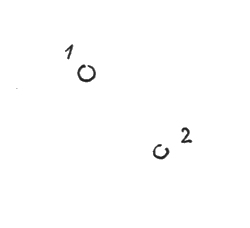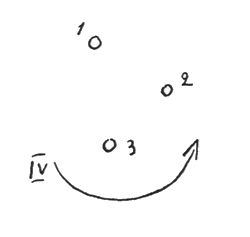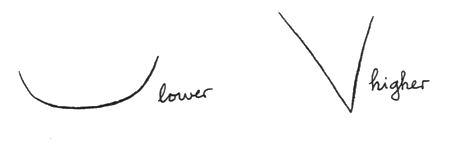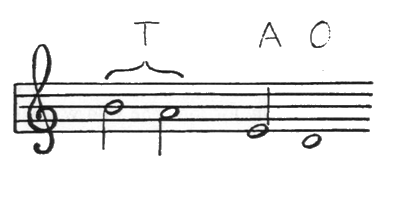Eurythmy as Visible Singing
GA 278
V. Choral Eurythmy
23 February 1924
You will have seen that it is quite possible for a single individual to express in eurythmy the essence of the musical element as musical element. We have tried to show how, for instance, the triad and the progression of the phrase may be mastered by a single person.
But the eurythmical expression of the musical element by a single person, from a certain point of view, is necessarily rather primitive, and is somewhat meagre when presented on the stage—although most beautiful and impressive performances can be given by a solo eurythmist. It is to be hoped that these solo performances will be valued, for they are a means whereby the actual essence of musical eurythmy may be revealed. In spite of this, it cannot be denied that a musical impression can also be given by means of the concerted working of a number of people, in other words by means of choral eurythmy. The point, however, is that we must not merely take these things schematically, but also enter somewhat into the quality of working together in artistic presentation.
I have emphasized what doing eurythmy entails: it is work to raise (heraufarbeiten) the physical human being (which really only ‘sounds’ in beat) to the etheric and the astral human being [see Appendix 2, final quotations]. And if we seek for Melos as such in the astral organization of the human being (and we seek for speech in the ego-organization), then we can perceive that which forms the fundamental basis of musical eurythmy. What you experience as astral human being usually remains stuck in a state of repose. But when you proceed a step further and present to the world that which otherwise remains in repose in the astral human being, you show, as it were, your spirit and soul nature. And it is this power of making things manifest which constitutes the most predominant element of all artistic endeavour.
At this point I will take the opportunity of alluding to a very, very remarkable contemporary phenomenon. My reason for doing so is, that if as eurythmists you can awaken a feeling for it, it would do much to help you in the actual artistic development of eurythmy.
During this course of lectures on tone eurythmy, I have often found myself thinking of a very significant Austrian musician of the present day. This musician, who was born in Wiener-Neustadt, opposes all modern music with extraordinary vehemence, denouncing it as ‘bad European music’. This in itself is an interesting phenomenon, and should be of special interest to eurythmists. Hauer [33] began to study music at a very early age, between his fifth and eighth to ninth years, by playing the zither, and he progressed far, coming to the view that it does not take much to acquire all that we presently call music. We can feel in Hauer's whole manner of expression that in a certain respect he is inwardly extraordinarily honest. On the one hand, he came to the conclusion that what goes by the name of music today is exceptionally easily come by, but, on the other hand, that precisely the musical element is missing, that we are led away from the musical realm. Indeed, very much of what I have to say about the eurythmic presentation of the musical realm can be found in Hauer's writings, although he expresses it in a stark and radical way. He speaks, for example, about atonal music.
I have said that the actual musical element, the spiritual element in music, lies between the notes, in the intervals, constituting that which we do not hear. In speaking about atonal music Hauer touches on something that is very significant and true. He is of the opinion that the production of a note or chord is nothing more than an appeal to the emotions or the senses—merely a means to express externally the inaudible Melos, which presents the inmost life of the human soul.
Now there is something so decadent and chaotic in the culture and civilization of the present day, especially where the arts are concerned, that your heart may well warm towards anyone who, with a certain instinctive flair, realizes that the music of today [1924] is not really music, but simply noise, and perceives that on which the musical element depends. It is, moreover, not difficult to understand that a man who has developed by himself out of all this can be absolutely furious with all European art. And this is true of Hauer. European art is absolutely repugnant to him.
All this is very interesting, and I have long been interested in this man Hauer. At the time when I was trying to lead over the musical element into eurythmy, I had to seek for some things that appear in Hauer, and I had to say to myself ‘It is certain that you could never take Hauer's atonal Melos as a basis for the gestures of eurythmy.’ The movements of eurythmy could not be found in this way. I had to ask myself: ‘Why is this so? Why is it not possible to come to eurythmic movements in this way, when Hauer undoubtedly feels the movement of Melos with such inwardness, and sees so clearly what is essential in the musical realm?’ In the case of Hauer, the explanation is simple. Hauer hates that civilization which marks the beginning of European culture—a civilization which the rest of humanity admires tremendously. He hates the civilization of Greece. He is a man who hates to excess the civilization of Greece.
Now it is interesting for once to come across a man who honestly and truly hates Greek civilization. There are any number of people who venerate it insincerely, by which I do not mean to imply that there are not others who venerate it with sincerity. To honour Sophocles and Aeschylus is a matter of course today, whereas to find anyone abusing Sophocles and Aeschylus as destroyers of art is an interesting phenomenon, and one which should not be overlooked. Hauer's view of the Greeks is based on the fact that, in his opinion, they brought everything that is related to art into the theatre, thus pouring everything that is audible into visibility: Now, after all, that is quite true. The question is whether we can also love the visible realm. If we are to find our way to eurythmy, we must of course be able to love what is visible. If we do not love the visible realm, honestly do not love it, preferring to remain in the audible realm, to stop with Melos, then we shall never be able to find any satisfaction in Greek culture, where everything was transferred into the sphere of what can be seen and understood.
Now among the orientals there were inspired teachers who truly wanted to listen to the audible realm. Oriental architecture was really music in space; it has within it a great deal of eurythmy. You actually see Melos pouring itself into movement. Europe possesses very little understanding for a musical architecture, as has been built with the Goetheanum here in Dornach, for the Goetheanum was, in a sense, a revolt against Greek architecture. There was very little suggestion of Greek architecture about it; but the Goetheanum was musical, it was eurythmic. [34]
Now, you see, Hauer actually hates speech, too, because speech does not stop with Melos, but (as I have already shown) does violence to it, pushing it into the outer world. For from the moment we utter sounds (and in so doing give ourselves up to what is demanded of us by the meaning of the sounds), from that moment onwards we become in a certain sense unmusical. The speaking of sounds is an art that in fact can only indicate a sounding of Melos. Melos may thus peep through, but it cannot be fully developed. You cannot form words according to the arrangement I proposed, as if the vowel sounds contained in them were really thirds or other intervals. You cannot do this, for the world does not permit it.
When (let us say) you feel wonder, an ah, and just after experiencing this sound you experience some feeling (let's say) which lies in the interval of the third compared to the former feeling, the world does not allow you to feel it. It's not possible, wouldn't you agree?—Life continually destroys that which is musical. Nature too is unmusical, and it is not from nature that we are able to derive that which is musical.
This destruction of what is musical extends to recitation and declamation. If there were only vowel sounds in speech, there would be no recitation or declamation, for the human being would always be yielding up his inner being (through pronouncing the vowels) to the outer world. There would be no declamation or recitation, for we would have to go along with the experiences of the world, and it would not be possible to conserve the musical element. That is why we have the consonants. The consonants are, as it were, the apology for the vowels. Man apologises to himself for the fact that, in the vowel sounds, he follows his own experiences. And when he fits in the consonants between the vowels, it is an apology for having become so foreign to himself. When you make the sound a follow an ah, forming thus either warte or balde (I have already spoken about these things) you have at the same time, in the consonants fitting themselves in between the ah and the a, an apology for the succession of the vowels.
In the case of that particular poem by Goethe, however, the vowels really make a musical effect, and consequently this apology of the consonants is not so much needed. When listening to this poem, a subtle, musical impression would be received if the speaker could achieve a swallowing of the consonants as much as possible, so that only the vowels were audible, with the consonants merely indicated.
Many other poems, however, really need the consonants. It may be said that the less musical a poem is, the more careful you must be to make the right use of the consonantal instrument (palate, mouth, lips, teeth, and so on). Then, in recitation and declamation, we have the apology for the offence committed by the vowels.
This will demonstrate that with the vowel sounds, which are an externalization of what is inward, the human being places a kind of caricature into the world. He is no longer himself. The human being is himself as long as he remains musical. When he becomes a vowel sound, he places a caricature in the world. With the consonants he once again recasts this caricature into the human form, and is then outside. He lays hold of an image of himself This corresponds to the vowel when framed by the consonants. In music we go more and more inwards. In speech we go further and further outwards. It is infinitely important for eurythmists to feel and experience these things, to develop a rounding-off of the artistic process, which is more than simply making or copying movements.
Taking this as your starting-point you will also be able to feel how choral eurythmy can be effective. In choral eurythmy we are dealing with a number of people. Let us first take the musical case: We have a metamorphosis of the motif, or phrase. We might express this metamorphosis of motifs in choral form by somehow grouping people together—three, let us say. We will let the first person present the first motif in eurythmy by moving in the form to the place of the second person, who will now take over the second metamorphosis of the motif. The first person remains standing. The second person moves on, passing the next metamorphosis of the motif over to the third person, who now continues the form to the place of the first (see Fig. 5). A kind of round dance can be brought about in this way.
It is only necessary in such a case for those who remain to continue to carry out the corresponding motifs while standing. In this simple way (where one person develops the motifs by moving, while the others retain their original motifs in standing), we have introduced a new variation into the motifs by means of eurythmy. By means of the motif which is in motion and the motif which is formed, in eurythmy we are able to introduee into the musical realm something which could never be expressed by the pure musical element, for in the pure musical element the previous chord or motif can no longer be retained after the new one has begun to sound.
Only think how often I have observed that, in the spiritual world, the past remains. In this development of the motifs through the chorus, the past remains (becomes engraved, so to speak, hardened), through the fact that the bearer of the motif in question carries out the movements while standing. This is one way.
Another variation appears when we have chords in the progressions of the motif. Here you can arrange the chorus in such a way that the chord is carried out by several people, and the motif is carried over to another group of people. In this way, one group expresses the harmonic element, and the harmonic development is then expressed by letting the harmony flow over from one group to another. Here we reach something very significant and totally different in its effect. When the progression of the motif is expressed in movement (the chord can also be represented by a single person, and the progression of the motif can also be expressed in movement by an individual), the space in which the movement occurs, and all the metamorphoses and transformations of the music, are filled out by the physical human being.
When making use of a chorus, however (we will suppose that you have one group of three people, and three more, and a further three, each carrying the progression of the motif from one group to the next), the element of visibility ceases to be [paramount], for when the motif is passed from one group to the next an invisible element wends its way through this choral dance. Here we approach very near to making this invisible element musical, very near especially to atonal music. Thus, by transferring to a chorus, the whole matter takes on quite a different aspect [from a solo performance]. In this way the aspect of the musical element which is becoming progressively unmusical, may be made musical once again by means of eurythmy, because movement makes it possible to appeal to that which is invisible. Thus, in this direction too, we shall possibly find that tone eurythmy is able to exert a corrective influence upon the musical element.
Now in the continuation of a motif everything will naturally depend upon the movement, but when the chord is being represented by a group, the relative positions of the people are of importance. The people in question (even when their group is moving) must endeavour to retain their relative positions. Your feelings will have to tell you this. Let us now suppose that we have to represent a triad. You can't place yourselves one behind the other (left of the diagram). You can and have to feel that you place yourselves in such a way that the first person stands here, the second here and the third in the middle (see Fig. 6).
Then, when the lowest note is taken by the first person, the next highest note by the second person, and the third note (if you wish, the fifth) by the third person, then you can tell by looking at it that the right thing has happened. The motif, when brought into movement, is carried over to the next group of people. And when the whole chorus is moving, each individual must endeavour to retain the right position in relationship to the others, so the whole design of the form (which is determinded by the relative positions of the people) may be expressed through this.
If we have a combination of two notes, the people can only be placed in this way:
We can feel that this is incomplete.
But now for the four-note discord. When you consider the artistic effect of placing three people as we did for the triad, and observe the complete grouping (which really does make the triad stand before us), then you will say to yourself: Where shall I put the fourth person? Whoever has artistic feeling will not find a place for a fourth person. Indeed no such place can be found. The fourth person can only be provided for by letting him or her move around the third person. There is no other way of doing it. You come to this by direct intuition. So now you already have an indication for the discord in the grouping. The group, the fixed configuration, can only express concords. The moment a discord enters, movement must be introduced into the grouping.
When you introduce movement into the grouping, you bring a challenge, and you can no longer remain still. The movement made by the fourth person (a movement necessary to the progression, to the resolution of the discord) is disclosed by its own nature.
You see, we have to look at things in this way if we are to gain insight into the gestures as the essential matter. Having gained this insight, you will say to yourselves: ‘What we do is the outcome of an intrinsic necessity.’ This is no infringement of freedom, although it does not open the door for purely arbitrary ideas. What always remains is the freedom to carry out the movements beautifully.
Choral eurythmy may be developed from the usual eurythmy which the individual presents. In particular, however, the following can be done. Let us suppose that in some piece of music we have the tonic, the dominant and the subdominant. To present this we take three groups of people and place the tonic with the first group, the dominant with the second group and the subdominant with the third, making those presenting the tonic have larger movements, whereas those presenting the dominant and subdominant make smaller ones. Now try to imagine how this would look. The frequent recurrence of the tonic is shown by the larger forms. The tonic is given prominence by the larger movements. It follows that the eurythmist who is moving these larger forms will quite naturally make larger gestures too, prompted by his or her feeling. The tonic, which recurs time and again, also recurs in the eurythmy forms. If these things are well practised in the way that has been explained, you will find that the character of each individual key [35] will be revealed, for you will be obliged to make the corresponding movements in the transitions.
The difference between major and minor keys appears very clearly with this interplay between the different groups [see Steiner's lecture notes, p. 24]. And when, in addition, you take into consideration the fact that every time a sound goes higher there should be the feeling that the eurythmist has to approach nearer to the audience, whereas when the sound goes lower the eurythmist has to move more towards the back of the stage—when all this is added you will have the whole musical element in a visual image.
There is still another point which belongs to this, that when a group comes to high notes, there must be a feeling that the movement has to be made more pointed, whereas when it is a question of lower notes, then it has to become rounder. Thus it may be said that a movement carried out with this gesture is lower, and a movement with this gesture is higher.
You will say: ‘These things present us with a great deal to learn, for in actual practice they are very complicated.’ Quite true! But they are no more complicated than learning to play the piano, or learning to sing.
I have indicated how the transition can be made from solo eurythmy to choral eurythmy. Real difficulties only make their appearance when we come to polyphonic music, but we shall speak about this tomorrow. In movement the whole affair will become even more disjointed than in the musical element as such. When we have a piece with many voices, therefore, we also have to make use of different people, and the quality of belonging together can only be achieved by means of a certain relationship in the form.
At this point I should like to develop a brief, esoteric ‘intermezzo’ for you. It has to do with the fact that the eurythmist has to use his or her body as an instrument. Only think of all that goes into the making of an instrument and how we appreciate certain violins which today can actually no longer be made. [Instruments made by Stradivarius, Guarnerius, and so on. (Translator's note.)] Think of everything that is involved in an external musical instrument. Now it is true that the human being is, in a certain way, exempt from these demands, for the divine-spiritual powers have already built him as an exceedingly good instrument. But actually the case is not so rosy, for otherwise every individual would find his body were the most perfectly suitable instrument. The eurythmists sitting here will be well aware of the great difficulties they have in overcoming bodily hindrances and impediments, if it is a question of arriving at eurythmy that is really worthy of the art.
The fact is that quite a bit can be done in order to work inwardly upon your body so that eurythmy to the sounds of speech and of music may gradually appear out of this body in a truly artistic, complete form. There is very little opportunity for this in the civilized life of Europe. European civilization has developed a view towards outer nature, but has not developed that which is necessary to give the human being a place in the world commensurate with true human dignity. And so people today have great difficulty feeling their real humanity within themselves.
Now what I have to say in this direction will not be immediately clear. It will become apparent through doing it. What I want to say in this connection is as follows. Listen to this progression of notes, which will at first seem very strange to you:
And now (to the pianist): Play the first two notes together and the next two notes consecutively, sustaining the last note for a long time. The first two notes, accordingly, played together and the last two notes one after the other, the final note sustained for a long time.
Now will someone who can do it well show this in eurythmy, simply in standing: B, A, along with E and D; the E short, and sustaining the last note for a long time.
And now I need somebody who will sing a word to this progression of notes; for there is a word which rings true when sung to this peculiar progression of notes, namely, the word ‘T A 0’. We are dealing here with the following: When expressing this in eurythmy (and here you must apply what has been given in these lectures) you have the seventh, the sixth, and only then the other notes. But you also have to feel the descending progression of notes, and then try to express this in eurythmy, not merely the notes. Hitherto you have become stuck in what is elementary, but you really have to express what I have said and then you will see that in the TAO you have a wonderful means of making your inner bodily nature flexible, inwardly supple, and able to be artistically fashioned for eurythmy. For when you lead the seventh and the sixth, as I have indicated them, down into the E and the D (that is to say you come into this second), you will see how by carrying this out you will gain an inner strength which you will be able to carry over into all your eurythmy. This is an esoteric exercise, and when it is carried out it means meditation in eurythmy.
And when you ask someone else (either singing or speaking in a reciting or declamatory way) to accompany these gestures with declamation or singing of TAO, you will see that in connection with singing, eurythmy and recitation, this is something like that which meditation is for general human life.
What I have given here is indeed an esoteric ‘intermezzo’, and it points the way to eurythmic meditation. We must go very far back, back to the ancient civilization of China, if we are to find our way into this meditation in eurythmy. [36] And you will understand that we can exercise a certain sympathy for someone who wants to get back to the ancient Orient in order to re-discover music, and whose feeling leads him to say: The Greeks have totally ruined music, and that is why the Greeks really had no proper musician—with the exception of the mythological figure, Orpheus. [12, end]
On the other hand, we can love the Greek civilization for its way of entering into the sculptural, plastic element. But one thing is true, that the Greek culture with its sculpture gradually was led away from eurythmy. Here we must compare the forms of oriental architecture, which really did transpose music into movement, with the forms of Greek architecture, which basically exhibit a dreadful symmetry. Here this dreadful symmetry rules. This, too, had to make its appearance in the world at some point.
The Greek culture did (I might almost say) tragically suffer the consequences of its civilization. It was a short-lived civilization, bringing about its own dissolution. The fault does not lie in the Greek culture: the fault lies in the fact that Greek culture is supposed to be forever reproduced in European civilization. It is, however, a kind of dissolution of this Greek element when we derive our movements directly from speech and singing, from the realms of speech and of music themselves. The difficulty people have in understanding eurythmy lies in the fact that European understanding has been, as it were, frozen into the reposing form, and is fundamentally no longer able to live in movement. The reposing form, however, should be left to. nature. When we come to the human being, we have to enter into movement, because the human being transcends the reposing, purely sense-perceptibly visible form.
That is what I wanted to say to you today.


